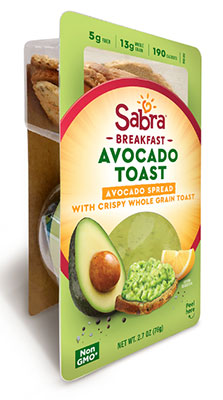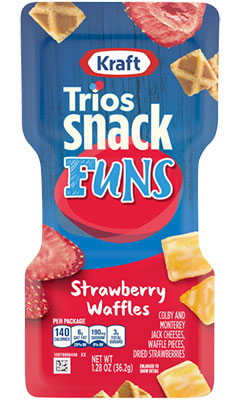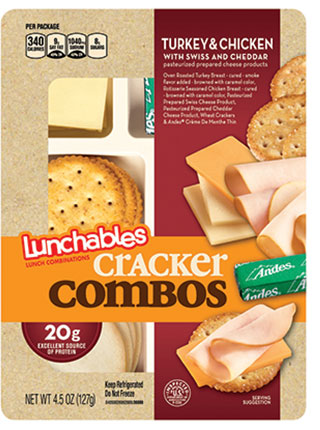Some foods just belong with one another. Consumers have been putting them together for years. Cheese and crackers. Pretzels and dips. And more recently, avocados and toast. Today, food manufacturers are catching on and turning combination products that once were only found in school lunchboxes into premium meal replacement options.
These mix-and-match products can be found for all dayparts. They are being marketed as convenient accompaniments for anyone on the go, and they offer a nutritional or indulgent appeal. Their evolution is driving growth and blurring several snacking channels into one. They are jumping out of the snack aisle to find new consumers. Although many new kits are merchandised in the refrigerated section of supermarkets and c-stores, their appeal is not cooling off.
According to Information Resources, Inc., refrigerated meat, cheese, cracker and dessert snacks’ dollar sales were up 13% for the year ended June 10, 2018. These products include Darlington, Md.-based Archer Farms’ On-the-Go snacks that feature salami, provolone cheese and breadsticks, or Broomfield, Colo.-based Horizon Organic’s Good & Go! Combination of pretzels and organic Cheddar cheese. These items are merging baked foods and meats or cheeses to create snacks that provide energy, protein and other nutritional benefits.
Future innovation in this arena may be guided by the health perceptions of snack foods and the key nutrients they offer. According to the International Food Information Council Foundation’s 2018 Food & Health Survey, 83% of Americans perceive fiber to be healthy, 80% said the same about whole grains, and 73% shared that sentiment toward plant-based protein. These more healthful offerings that highlight nutritional benefits may prosper by making a case for reducing any of the guilt people may feel when treating themselves between meals.
Evolving for us
Consumers are no longer prioritizing traditional meal times but are increasingly snacking throughout the day. A 2018 GlobalData consumer survey showed that just 9% of Americans said they do not snack outside of mealtimes. Tom Vierhile, innovation insights director, GlobalData, said that an analysis of snacking times points to opportunities for combination snack producers.
 While it’s nothing new, 70% of Generation Z consumers, people born in 2000 or later, said they are most likely to snack between lunch and dinner as opposed to before breakfast, between breakfast and lunch, or after dinner, according to GlobalData. The same daypart also was favored by Generation X, baby boomers and the silent generation.
While it’s nothing new, 70% of Generation Z consumers, people born in 2000 or later, said they are most likely to snack between lunch and dinner as opposed to before breakfast, between breakfast and lunch, or after dinner, according to GlobalData. The same daypart also was favored by Generation X, baby boomers and the silent generation.
Millennials, on the other hand, were outliers as the highest percentage tabbed “before breakfast” as the time of day when they snack.
“This suggests that millennials, a group that is now being weighed down by family opportunities, may be more inclined to skip breakfast but still need something to jump start their day,” Mr. Vierhile said. “That may explain some of the innovation we are seeing in yogurt products with crunchy mix-in ingredients, which turn yogurt into more of a snack product.”
Yogurt products combined with baked foods include Minneapolis-based General Mills Yoplait and its Mix-Ins Yogurt and Salted Caramel Pretzels. The product is presented in 5.3-oz plastic cups with two compartments, one holding the yogurt and the other with pretzels. The package is perforated to allow the user to pour the pretzel topping into the yogurt.
“The mixing in of sweet and crunchy toppings helps to move traditional yogurt, commonly consumed as a breakfast item, into the snacking category thus broadening consumption opportunities and profit potential for brands,” Mr. Vierhile said.
Evolving eating patterns can be seen throughout the day. A recent OnePoll survey found that lunch is the meal most often replaced with snacks with 49% of respondents saying they do so. The survey also found that cheese, crackers, fruit, chips, nuts and vegetables were the top six foods that make up snack meals.
Sally Lyons Wyatt, executive vice-president and practice leader, client insights, I.R.I., explained that combination snacks have been around for years, but they have evolved to meet current trends.
“It used to be simple chip and dip combos or cheese and cracker combos,” Ms. Lyons Wyatt observed. “We are now seeing more variety that goes beyond cheese and crackers and includes meat, nuts, fruit, spreads, dips and yogurt. In addition, this variety is found in both mainstream and premium products.”
For example, instead of an everyday cracker, combination products now include a premium cracker, crisp or multigrain bread. Ms. Lyons Wyatt said consumers also are now seeing combos expanding from savory to sweet. Churros are now paired with a caramel dipping sauce in one convenient package. Snack kits now feature sweet and savory options like cheese, nuts, fruit and dark chocolate.
Stirring in substance
Creating snacks that offer nutritional benefits and pair grain-based foods with a variety of proteins is a way to attract consumers.
“A lot of the innovation we are seeing today is intended to capitalize on the popularity of protein, a nutrient that seems to have escaped the negativity that fat, sugar, or carbohydrates have suffered from,” Mr. Vierhile said. “This is why so many of these combination snacks feature meat or cheese as an ingredient as both or are relatively high in protein.”
Natural Meat & Cheese Plates from Oscar Mayer, Madison, Wis., include garden herb whole wheat crackers, 18 grams of protein per package, no added hormones and no artificial ingredients, flavors or colors. Kraft Heinz introduced Cheese Dip and Crackers under the Cracker Barrel brand. The snack comes in several flavors: Garlic Herb Jack Cheese, Cracked Black Pepper Parmesan and Sharp Cheddar. Each is served with whole wheat crackers.
Keebler Co., a division of the Kellogg Company, Battle Creek, Mich., offers a Town House Pita Crackers + Hummus Snack Box. Inside each box are three individual bags of pita crackers and three individual plastic cups of hummus that do not require refrigeration until opened.
Sabra Dipping Co., White Plains, N.Y., is tapping into one of today’s most popular ingredients — the avocado. Sabra Guacamole with Tostitos Rolls by Frito-Lay, Plano, Texas, is a co-branded product that expands the interest of shoppers based on the dip and the chips. The shrink-wrapped 2.8-oz container features a plastic bowl of dip with a cup-shaped top that holds the chips. The 220 calories per single-serving package may be seen as a portion-control snack.
Additionally, Sabra Breakfast Avocado Toast is a refrigerated fresh blend of Hass avocados to create a spread designed for breakfast or brunch. Paired with crispy whole grain toasts, the snack is an on-the-go breakfast option that might appeal to the millennials looking for a quick morning snack.
Hillshire Snacking, Chicago, offers a line of Small Plates snacking trays. The brand features 11 signature Small Plates with charcuterie combinations of meat, cheese, crackers, crisps and nuts.
“Protein in particular is a major point of interest for our consumers,” said Colleen Hall, marketing director of Hillshire Snacking. “Hillshire Snacking prides itself in its thoughtfully curated, high-protein snack offerings that can be enjoyed on-the-go and include superior seasoned meats, natural cheeses, blends of flavored nuts along with crisps and toasted rounds.”
Clearly, combination snacks have come a long way from the original Oscar Mayer Lunchables.
Grown-up snacking
Despite a perception that Lunchables were made for children, the popular kits have stood the test of time and been adopted by many adults as convenient snacks.
“Products like Lunchables that helped create the combination snack sector have, over the long term, increasingly targeted older children with more substantial offerings, and this may have paved the road for innovation in more sophisticated combination snacks that are aimed at adult consumers,” Mr. Vierhile explained.
The combinations category is split into children and adult segments. While children carry significant weight in the marketplace, the adult segment, which Hillshire Snacking plays into, is currently experiencing tremendous growth.
 “The rise of adult snacking is very tied up in the shift we are seeing away from the traditional model of three square meals a day and toward daily snacking,” Ms. Hall said. “Hillshire Snacking is excited to be in a position to give adults substantial, satisfying options that they can feel good about eating and that make them feel good throughout the day.”
“The rise of adult snacking is very tied up in the shift we are seeing away from the traditional model of three square meals a day and toward daily snacking,” Ms. Hall said. “Hillshire Snacking is excited to be in a position to give adults substantial, satisfying options that they can feel good about eating and that make them feel good throughout the day.”
While Hillshire Snacking is directly targeting adult consumers, other brands are leveraging combination snacks that appeal to the entire family. Anne Field, head of marketing for Kraft-Heinz, Chicago, said the company’s inspiration for its SnackFulls is partly fueled by consumers’ need for portable solutions for themselves and their children. The SnackFuns line is created for children while its SnackFulls line targets older consumers.
“Consumers are not looking to trade convenience for quality; they are looking for trusted brands and snacks that also fulfill their health-conscious mindset,” she said.
Kraft SnackFulls are offered in combinations that include dried fruits, dark chocolate and natural cheeses. SnackFuns appeal to children with combos including a Strawberry Waffles variety that features dried strawberries, waffle crisps and Colby Jack cheese.
Future of fusion
Snack pairings in single-serve packages are redefining the way some people eat. The products are addressing U.S. consumers’ need for on-the-go foods that deliver nutrition and dietary needs. Food manufacturers are going beyond snacking and into meal replacements and even dessert.
“The variety of assortments being put into the marketplace and the availability across many outlets drive usage across the day and by more people,” Ms. Lyons Wyatt said. “We do see this trend continuing for years with more assortment and availability in refrigerated and shelf stable.”
Kraft’s Philadelphia brand recently launched Multigrain Bagel Chips & Cream Cheese Dip varieties that include brown sugar and cinnamon, garden vegetable, strawberry, and chive and onion. The 2.5-oz refrigerated combinations are sold in a divided plastic tray and provide consumers with a crunchy single-serving snack pack with bagel chips and cream cheese.
GlobalData surveys suggest that combining snack options is a strategy for success for many brands. Just 15% of American consumers said they typically eat meat snacks like jerky and only 29% said they typically snack on cakes or pastries, according to GlobalData’s 2018 third quarter consumer survey. Combining meat with crisps and cheese or cake products with fruit and nuts might increase the combo consumption.
“Combination products give the consumer permission to snack on products that, by themselves, may not be in a position to gain much traction as snack items,” Mr. Vierhile said. “Foods like cheese slices, hummus, meat chunks and even guacamole may fall in this category. Taking these foods and adding chips or crackers to them turns these items into products that are more likely to pass muster as a snack or a mini-meal.”
GlobalData projects that the growing demand for quick, nutritious, energizing snacks will help sustain the on-the-go combination trend for the foreseeable future.




